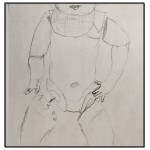LCC grade 6 students touch upon the causes of the Second World War and the atrocities of the Holocaust. Here is a sampling of reflections from some of our students about their recent visit to the Montreal Holocaust Memorial Center. Students also sketched an artifact that they saw at the museum.
Choose and describe an artifact that interests you and why you chose it.
_____________________________________________________________________________
The artifact was a doll. It was found in the Warsaw Ghetto by Thea Borzuk’s dad in an abandoned apartment. She took it when the family escaped the ghetto and played with it when they lived in hiding. The whole family survived and they moved to Canada in 1950. I chose the artifact because I thought it was interesting how it was found and how the owner escaped the ghetto and lived in hiding until the end of the war. – Sebastian J.
My artifact is a blue and white striped dress that was worn in a concentration camp as it was the uniform that had to be worn. Men wore striped pants and shirts in the same colours, blue and white. I chose this artifact because I found it interesting that someone had actually worn it a long time ago and how so many people must have worn it, as it was all tattered. – Chloé
The artifact I chose is a purple heart shaped booklet with the letter F on the front of it. They used pieces of black bread spread with margarine as glue. It was used as a birthday present for a girl (Fania). Since they were in Auschwitz, it was forbidden to have art materials so Fania’s friend had to steal some materials. This booklet had 20 pages in it and each woman signed it. There were two heart-shaped purple pieces of fabric from a blouse stuck on with bread and the notes. I chose this artifact because I found it really interesting how the heart was made and I think it was very thoughtful and I also found that it was very cool that so many of her friends signed it. I think it was also very brave for the girls to make her a birthday present. – Jordan
The artifact I chose is a voting ballot. It was used in the second round of the Presidential elections in Germany. I chose this artifact because on the ballot someone had voted for Hilter, who soon became chancellor of Germany. Also, I thought it was an intriguing artifact that I wanted to learn more about. – Emma B.
I chose the poster identifying the different types of prisoners in the concentration camps. This poster identifies what type of prisoners were in the Ghettos. Each prisoner had a badge, for example, political prisoners had a red triangle. There was a classification and badge for every type of prisoner. – Bogdan
The person who used my artifact was a female doctor named Ginda Kalujna Rosenblatt. During the war when some soldiers went to see her and another doctor, they told the soldiers that they had fake heart ailments so they couldn’t participate in the war. I chose this artifact because when I saw it made me think what it was and who used it. After some research I figured out that it was a syringe kit and it belonged to Dr. Ginda Kalujna Rosenblatt. It was used in 1920. – Emanuel
The artifact looks like a yellow and red Star of David. It was a badge that told the Nazis that the person who wore it was a political prisoner and a Jew. It was one of the many badges to tell the SS guards why the person had been incarcerated. I chose this artifact because I was very interested in how the Nazis organized themselves to pull off a mass murder with the help of badges. – Grayson
-

-
Chloé – Prisoner Uniform
-

-
Emanuel – Syringe Kit
-

-
Emma – Voting Ballot
-

-
Jordan – Heart of Faria
-

-
Sebastian – Doll
-

-
Grayson – The Star of David identifying Jews
-

-
Bodgan – Badges Poster





















